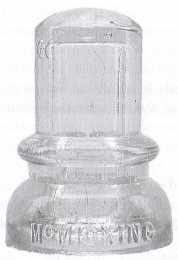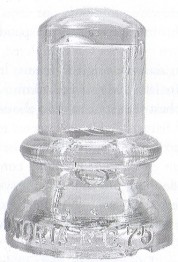The McMicking Insulator
by Carol McDougald
Reprinted from "Crown Jewels of the Wire", May 2001, page 22
Diligent digging by collectors over the past twenty-five years have unearthed
a good supply of this historic insulator that built the telegraph lines of
British Columbia. Today, it is probably still one the most affordable threadless
styles one can add to their collection.
The CD 734 is made of quality glass and can be found with two different
embossings. . .which involve the placement of "periods", period!
(after the C in B.C)
(F-Skirt) McMICKING
|
(R-Skirt) VICTORIA. B.C 75
|
 |
 |
|
(F-Skirt) McMICKING |
(R-Skirt) VICTORIA. B.C. 75 |
Most units are a uniform light blue aqua or slight variation of that color,
with only a few examples having been found in a light green. Russ Paton, writing
in the Canadian Insulator Collector, March/April 1995, indicated that there are
a number of variations in height. "The height difference is caused by
varying amounts of glass below the embossing line. The tall variants have
approximately 5.0 - 6.0 mm of glass below the embossing line, where as the short
variants have less than 1.0 mm below the embossing. I believe that the height
difference in the molds was caused by base wear, and subsequent re-machining of the
bases. There is much speculation about the manufacturer of these insulators,
very little of which leads to a firm conclusion. My personal opinion is that
they were produced in British Columbia. The only other insulator that resembles
the CD 734 is the CD 734.8 'baby Battleford' (also of unknown manufacturer).
Both of these insulators have similar profile, size and glass button on the
inside top of the pinhole."
During the period in which Robert McMicking was
employed by the government telegraph system, he was involved in the development
of the lines throughout B.C. for a period of ten years following 1870.
"One
of these lines, it appears, was let out to a contractor by the name of F.J.
Barnard, to run up the North Thompson River from Kamloops to Tete Jeun Cache. In
1875, materials of wire, insulators and side blocks were taken up the river by
the stern wheeler, the S.S. Martens. Mr. Barnard then cached these materials six
miles south of the little town of Avola, the spot being known as 'wire cache'.
For some reason the contract was not carried out, and these materials were
abandoned. It was at this spot in the summer of 1976 that I found several
McMicking insulators, as well as some mule shoes. It was also interesting to
note that some of the homesteads in the vicinity had old telegraph wire strung
up for fence, and that the forest service had used some of these insulators for
stringing up a line to a lookout near the area." So wrote John Werstuik in
an article on the McMicking insulator in Crown Jewels of the Wire, August 1977.
In late 1974, Wilf and Margaret Secord unearthed a shattered McMicking
threadless near the "wire cache" where a wooden bridge used by logging
trucks crossed the North Thompson River. The next year, while passing the same
location, the Secords found that the embankment had been eroded by water and
there were a half dozen insulators laying on top of the ground. They spent three
days digging on that stop.
Eight years later, the Secords once again stopped at
the river crossing. Only this time, the old bridge had been replaced by a new
span. Timbers from the old bridge had been brought up from the river bed, and
with it, glass shards that were reminiscent of the old threadless McMickings.
Excavating with shovels and rakes, a second supply of insulators were found.
Most of the CD 734's in today's collections were lovingly unearthed by Margaret and Wilf and a handful of other
collectors who spent time turning the soil in British Columbia.
To bring the McMicking story up to date, we need to turn to Mark Lauckner who
was featured in a Victoria, B.C. newspaper article about the significance of
insulators as "historical communications artifacts". Several phone
calls resulted from that newspaper story and color photo of Mark admiring a
peacock blue signal! The most exciting call was from "an elderly woman in
Victoria. She asked me if I knew who Robert McMicking was. I said I knew a great
deal about him. She informed me that she was his granddaughter, and that she has
an old trunk full of his 'stuff', and that she would like to give it to me. I
told her that I would like to review it then pass it along to the Provincial
Archives of B.C. She invited me over for tea..." (Canadian Insulator
Collector, May/June, 1996)
Mark did indeed have a visit with Maude Church, the
granddaughter of Robert McMicking. And Mark was able to obtain wonderful
photographs of family photos which he published in Canadian Insulator
Collector,
July/August 1996 as its editor.
In that same issue, Mark shares his favorite
McMicking story told to him by Maude: "Robert was 17 when his older
brother, with his military background, was chosen to lead the wagon train
heading west from Ontario to the gold strikes of B.C. Robert really wanted to
go, but his brother told him he could not because he was just a kid. As the
wagon train was a few hundred feet long, he hitched a ride with the last coach
in the line, totally unknown to his brother who was up at the front. It wasn't
until a week later that he was discovered by his brother. He became known as the
'Jimmy run boy' because of his young age, and was used as an errand boy by the
Overlanders. One day he was sent to a shop for supplies, and as he was being
served he heard the telegraph sounder clicking away in the background. When he
asked the shopkeeper if he was going to respond to the message, he replied that
the telegraph agent was often a home sick, and he couldn't understand the code
anyway. Robert told the shopkeeper what the message said, as he learned the
telegraph code back in Ontario. The shopkeeper instantly gave him the job."
Patting the thick McMicking family scrapbook, she remarked, "None of this
would have happened if he [grandfather Robert] wasn't sent for groceries that
day."
|
